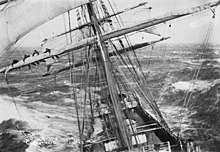Nautical operations
The plan includes leaving the dock and harbor area, the en route portion of a voyage, approaching the destination, and mooring.[7] Integrated systems take inputs from various ship sensors, electronically display positioning information, and provide control signals required to maintain a vessel on a preset course.The chief mate's primary responsibilities are the vessel's cargo operations, its stability, and supervising the deck crew.The chief mate also trains the crew and cadets on various aspects like safety, firefighting, search and rescue, and other contingencies.The third mate's primary duty is matters of safety, inspecting gear lockers, lifeboats, and all equipment on board ensuring that it is safe and operational.This includes not only the engine and the propulsion system, but also, for example, the electrical power supply, devices for loading and discharging, garbage incineration and fresh water generators.The department and its manning requirements, including the responsibilities of each rank are regulated within the STCW Convention, applicable only to the merchant fleets of countries who have ratified it.[10] These include the ship engine, fuel oil, lubrication, water distillation, separation process, lighting, air conditioning, and refrigeration.[citation needed] The chief cook is the senior unlicensed crew member working in the steward's department of a ship.[citation needed] In the Hellenistic era, as civilizations around the Mediterranean grew in size and complexity, both their navies and the Hellenistic-era warships such as galleys became successively larger.The size of the new naval forces also made it difficult to find enough skilled rowers for the one-man-per-oar system of the earliest triremes.Fleets with large galleys were put in action in conflicts such as the Punic Wars (246–146 BC) between the Roman Republic and Carthage, which included massive naval battles with hundreds of vessels and tens of thousands of soldiers, seamen, and rowers.[15] Most of the surviving documentary evidence comes from Greek and Roman shipping, though it is likely that merchant galleys all over the Mediterranean were highly similar.In Latin they were called actuaria (navis) ("ship that moves"), stressing that they were capable of making progress regardless of weather conditions.As an example of the speed and reliability, during an instance of the famous "Carthago delenda est" speech, Cato the Elder demonstrated the close proximity of the Roman arch enemy Carthage by displaying a fresh fig to his audience that he claimed had been picked in North Africa only three days past.The Romans had several types of merchant galleys that specialized in various tasks, out of which the actuaria with up to 50 rowers was the most versatile, including the phaselus (lit.[18] Richard Henry Dana Jr. and Herman Melville each had personal experience aboard sailing vessels of the 19th century.[20] Melville described the crew complement of the frigate warship, United States, as about 500—including officers, enlisted personnel and 50 Marines.He additionally named such positions as, boatswains, gunners, carpenters, coopers, painters, tinkers, stewards, cooks and various boys as functions on the man-of-war.




prime verticalPassage planningmooringcaptainnavigatorhuman errornautical chartsrisk managementInternational Maritime OrganizationCode of Federal RegulationsIce navigationhydrographicBridge (nautical)Seafarer's professions and ranksSea captainstand watchDeck departmentlicensed marinersFirst mateSecond mateThird mateDeck cadetapprenticeBoatswainAble bodied seamanOrdinary seamanEngineering officer (ship)merchantSTCW Conventionnavigationbridgestabilityballast watermooring operationsanchoringengine departmentpropulsionship enginefuel oillubricationdistillationseparation processlightingair conditioningrefrigerationmerchant shipsengine officerswatch officerelectro-technical officerfiremansteam enginescoal trimmerautomationChief stewardAncient navies and vesselsAncient maritime historyGalleyTriremeHellenistic eraHellenistic-era warshipscatapultstriremesAlexander the GreatDionysius I of SyracusePtolemy IIPunic WarsRoman RepublicCarthageCarthago delenda estCato the EldergladiatorAge of SailSailing shipseamenRichard Henry Dana Jr.Herman MelvillePilgrimfrigateUnited Statesdoctoral degreeShippingCargo vesselUS Naval AcademyState University of New York Maritime CollegeUniversity of PlymouthKingsborough Community CollegeShipmaster (captain)Officer of the watchChief mateAble seamanChief engineerSecond engineerThird engineerFourth engineerMotormanSteward's departmentPurserChief cookStewardMaritime pilotSailorFishing vesselsDriftersFactory shipsFishing fleetLonglinersResearch vesselsSeinersTrawlersWhalersTraditionalTraditional fishing boatsArmadahanBangkaBasniganBawleyBokkuraBrixham trawlerCaïqueCamakauCape IslanderCoracleCurrachDoggerDugoutFalkuša